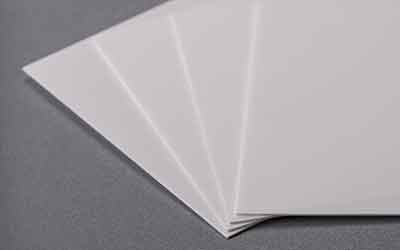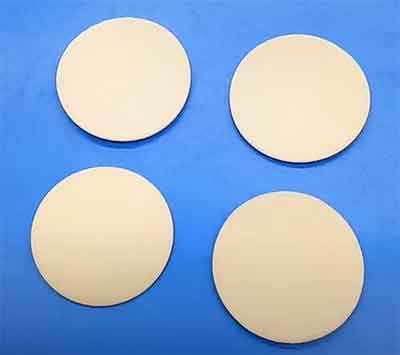Alumina Wafers in Stock!
Below is one example of the Alumina Wafer that we sell. Pricing depends on quantity.
Alumina Substrates
High purity (> 99.5%) recrystallized Alumina Substrates (Al2O3),
Thickness: 0.5mm
Size: 2” X 2” X 0.5mm;
Grain size: ~ 1-10micrometer
Contact us for pricing.
Get Your Alumina Quote FAST!
Alumina Wafers for Laser Ablation Tests
Researchers use the following wafers for laser ablation tests to demonstrate laser capability.
I'm looking to purchase 5-10 pieces of Alumina substrates for laser experiments. So I do not have specific requirements on purity or grain size. 'Typical' specs are fine with me (if that helps). I'm looking for size of 2" (either square or circular shape) in dimension. 0.5mm or thicker thickness is fine. Could you please provide me a quote with lead-time information included as well?
I do not care about Ori and surface finish.
Is it possible for you to give me a quote on the cheapest option?
What Alumina Wafer Specs are Used to Fabricate Chemical Testing Devices?
Alumina wafers 100mm diameter no flats needed 0.800mm 1 side polish Exw price $reference # 265621 for pricing
What are Alumina Wafers?
Alumina substrates are excellent bioengineering materials. The non-calcined alumina sample has a high pore  size distribution and can be used to reduce cell spreading, activation, and aggregation. Calcined alumina has a low pore size distribution, but its surface is flat and smooth. Microstructural differences between the two alumina samples can affect the attachment and survival of cells.
size distribution and can be used to reduce cell spreading, activation, and aggregation. Calcined alumina has a low pore size distribution, but its surface is flat and smooth. Microstructural differences between the two alumina samples can affect the attachment and survival of cells.
Alumina has excellent mechanical and thermal properties, making it a suitable thin-film ceramic substrate. Its high density makes it an excellent electrical insulator and has very little porosity. It is white in color, and its bulk density and Vickers hardness are comparable to those of silicon and other materials. Its high-density form is ideal for use in thin-film devices, as its porosity content is low.
Alumina substrates are available in a thick and thin film form. Thick-film alumina substrates are manufactured using a dry-pressing process. The resulting films have a high alkali-earth silicate content and are used for applications like tissue engineering implants and stem cell seeding scaffolds. They have an array of biological applications in vitro and vivo. You can find an alumina substrate that meets your needs and meets your budget.
The properties of 96% alumina are similar to those of high-density alumina. Their main difference lies in their lightness. Alumina is ideal for filtration, homogeneous diffusion, and electrostatics. It is available in many different sizes and thicknesses, ranging from 4" x 6" to 16" x 168". For further details, you can refer to the data sheet provided by the manufacturer.
Alumina Substrate Research
Silicon nanowires (NW) have been studied in a range of applications including
semiconductors, photovoltaics,  solar cells and solar modules. The key to the success of the materials used in these applications is their ability to avoid particle contamination. In combination with modern substrates and materials, other coatings can make a difference in product performance and service life. As far as this can be achieved without prohibitive costs, it is of great importance in the growing number and use of nanotechnological applications. [Sources: 0, 1]
solar cells and solar modules. The key to the success of the materials used in these applications is their ability to avoid particle contamination. In combination with modern substrates and materials, other coatings can make a difference in product performance and service life. As far as this can be achieved without prohibitive costs, it is of great importance in the growing number and use of nanotechnological applications. [Sources: 0, 1]
Expanding the current process to include wafer scale ranges at reasonable cost expands the number of possible applications. Further studies are needed to use this type of nanowires in photovoltaic devices, as recent results have shown the potential for use in solar cells and solar cells. [Sources: 1]
The study focuses on the leading players in combination with various market dependencies and their market shares, as well as the landscape and contrast analysed in detail. The forecast is a specialized and in-depth industry research that deals with technical and profitable business prospects. This report provides a detailed analysis of current market trends in the alumina wafer market and reveals the investments that are to be made in this area. [Sources: 3]
P pulse deposition produces better results than classical electrodeposition, because ions migrate more easily through the pores on the silicon surface. Re-anodisation techniques were studied to form a more flexible, durable and efficient silicon wafer material. Water-based tape for the production of high-quality, flexible and flexible polymers and polyester wafers. [Sources: 1, 4]
The final effectors must have a good weight-to-stiffness ratio and be as pure as possible to minimize the risk of contamination during wafer processing. The use of intermediate layers for resistance transfer also enables work with wafers already processed compared to nanoindentation. Because the wafers are thin and fragile, they must be carefully physically treated, while cleanliness is essential to prevent contaminated particles from entering the wafer lens. [Sources: 0, 1]
The graphite component can also be treated with a glassy carbon layer that prevents the production of surface particles, reduces porosity and permeability of the sealing surface and has excellent release properties. This material purity is an advantage over sic-coated graphites (wafer carriers), which can contaminate the MOCVD chamber by eating away the coating and exposing ammonia to graphene. CDVs offer unmatched erosion resistance, and the high quality of the material results in a high-quality, cost-effective product. [Sources: 0]
More specifically, porous AAO can be used to control the growth of monocrystalline nanowires during chemical vapor deposition (CVD). Pyrolytic boron nitride (PBN) is available, which operates at temperatures above 1500 degrees Celsius and has a wide range of chemical properties, such as high thermal conductivity and high surface area. Modern CVCs with PBN materials are particularly suitable for high-temperature, low-pressure and ultra-thin films. The walls of the chamber can also be coated to improve the chemical stability of the material and its ability to work at high temperatures. [Sources: 0, 1]
At the same time, after exposure, a large surface can be made of perfect porous clay, and the pores are positioned to form an impression of three pores. This shape requires a less dense set of pits, which leads to the creation of another. Such a targeted assembly approach is a very interesting concept and allows a silicon wafer to be supported by a single layer of porous AAO, rather than by multiple layers of different thicknesses and sizes. [Sources: 1]
The growth of silicon nanowires is possible by etching with wet 1 HF, whereby the aluminum matrix can be removed, resulting in the generation of a silicon wafer with a thickness of only 1 mm, as shown in Figure C. This expansion makes this performance possible for the first time in the production of high-performance silicon chips. [Sources: 1]
Support of planar fuel cells: a multi-layered casting process for the production of silicon wafers with a thickness of 1 mm. [Sources: 4]
The sacrificial layer of aluminum is oxidized in the pores arranged in hexagonal arrays as shown in Figure A. Subsequently, the oxide layer is removed and the stencil is made of both aluminum and oxygen. Silicon is present in both the template and the pores, and gold is presented at the top of the silicon wire. In addition, ions of gold and copper oxidize at a rate of 1.5 to 2.0 times as fast as normal, while oxygen oxidizes an average of 0.2 to 1,000 times. [Sources: 1]
Elements from the periodic table of the alumina wafer are printed on a single layer of silicon wire on the top of an aluminum template. Elements in the periodic table of alumina wafers printed in a one-atom-thick layer on an aluminum template (Figure A). The Element Periodic Tables of aluminium wafers are prints in a 1.5 by 1.6 metre layer. [Sources: 2]
The structured coating has a rounded morphology that contains particles in a sharp morphology generated by bead beams. Large rings are observed in the FT made of double anodized alumina, which has less thick and prominent circles. [Sources: 0, 1]
Sources:
[0]: https://www.cleanroomtechnology.com/
[1]: https://www.ncbi.nlm.nih.gov/pmc/articles/PMC3686656/
[2]: https://www.desertcart.com.kw/products/14147449-alumina-scoring-wafer-for-glass-element-lanthanum
[3]: https://scientect.com/news/1335590/global-thin-film-amorphous-silicon-solar-cell-market-2020-covid-19-update-future-challenges-growth-statistics-and-forecast-to-2025/
[4]: https://www.cambridge.org/core/journals/journal-of-materials-research/article/tapecasted-transparent-alumina-ceramic-wafers/1E3E7A5CDC92D235842B255E4F253574
